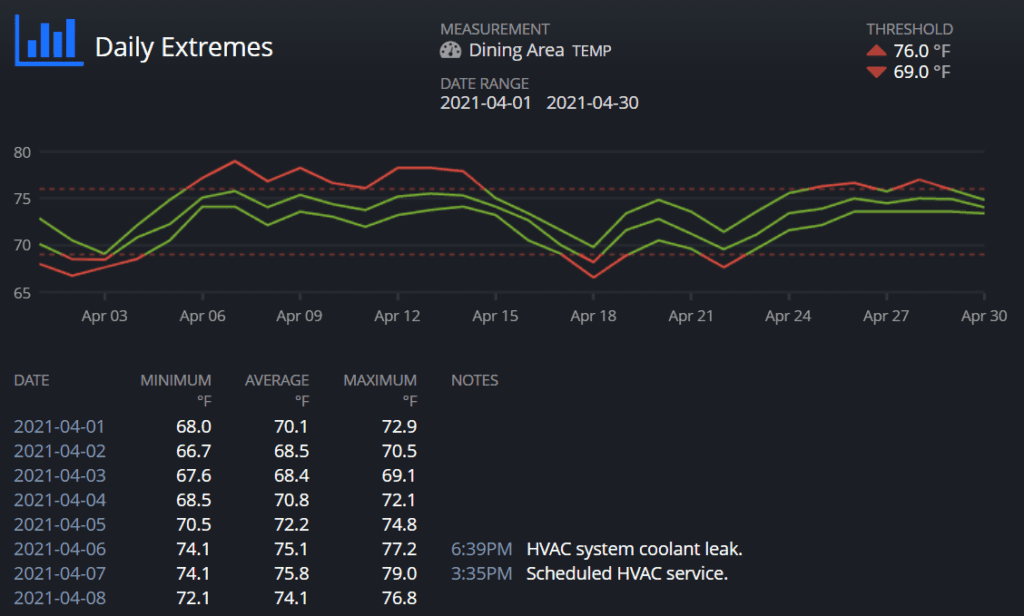Wireless temperature sensors are a type of small, low-cost measuring device that record and wirelessly transmit temperature readings to a receiver or gateway. These sensors are used in a wide variety of applications, including food storage, medical labs, food processing, and manufacturing.
Wireless temperature sensors work by detecting changes in temperature and then transmitting that data wirelessly to a receiver (gateway). The two main components of a wireless temperature sensor are the sensor and the transmitter. The sensor is the part of the device that measures the temperature, while the transmitter is responsible for transmitting the temperature data to a receiver.

A. Swift Sensors – Thermistor Sensor B. Swift Sensors – Thermocouple Sensor
There are several types of sensors that can be used in wireless temperature sensors. The most common types of sensors are thermocouples, thermistors, and resistance temperature detectors (RTDs).
Thermocouples work by measuring the voltage that is generated when two different metals are joined together. When the temperature changes, the voltage changes as well. Thermocouples are commonly used in applications where high temperature measurement is required, such as in industrial applications.
Thermistors are semiconductor devices that work by measuring changes in electrical resistance that occur as temperature changes. They are highly sensitive to temperature changes and are commonly used in temperature measurement applications that require high accuracy.
RTDs work by measuring changes in electrical resistance that occur as temperature changes. RTDs are highly accurate and can be used in a wide variety of applications, including industrial and laboratory applications.
Once the sensor has measured the temperature, the data is transmitted to an internal transmitter inside the sensors, similar to a small radio. The transmitter is responsible for collecting and transmitting the data to a receiver. The receiver is a small network device also known as a Gateway.

Sensors transmit temperature readings to a Gateway. Gateway transmits temperature readings to the Cloud.
There are several different types of transmitters that can be used in wireless temperature sensors. The most common types of transmitters are radio frequency (RF) transmitters, Bluetooth transmitters, and Wi-Fi transmitters.
RF transmitters work by transmitting data using radio waves. RF transmitters are commonly used in industrial applications, where long-range transmission is required.
Bluetooth transmitters are commonly used in consumer applications, such as in-home temperature monitoring systems. Bluetooth transmitters work by transmitting data over short distances, typically up to 30 feet.
Wi-Fi transmitters work by transmitting data over a wireless network. Wi-Fi transmitters are commonly used in applications where real-time monitoring is required, such as in HVAC systems and manufacturing processes.
The receiver, often referred to as a Gateway, is responsible for receiving and processing the temperature data transmitted by the transmitter. The gateway may be connected to the cloud or a local a computer or other device that is capable of displaying the temperature data in real-time. In some cases, the receiver may be connected to a central monitoring system that is capable of monitoring multiple sensors in real-time.
Wireless temperature sensors have several advantages over traditional wired temperature sensors. Wireless sensors are more flexible and can be used in a wider range of applications. They are also more cost-effective, as they require less installation and maintenance than traditional wired sensors.
These sensors can also be used in applications where wired sensors are not practical, such as in outdoor or hard-to-reach locations. In addition, wireless temperature sensors can be used to monitor temperature in real-time, allowing for faster detection of temperature changes and more efficient management of temperature control systems.
Wireless temperature sensors are also highly accurate and reliable. They can provide temperature data in real-time, allowing operators to quickly identify and address any temperature issues before they become a problem.
Temperature sensors are becoming a critical tool in virtually every industry as they allow temperatures to be monitored automatically and consistently… 24/7. Long gone are the days when employees had to take time to manually record temperatures.

Wireless Temperature Sensors record data that can later be used in Compliance Reports.
As the demand for real-time temperature monitoring continues to grow, we can expect to see even more advancements in wireless temperature sensor technology. These sensors have the potential to revolutionize a wide range of industries, from food storage and manufacturing to healthcare and agriculture.
You can learn more about complete temperature monitoring solutions here.
